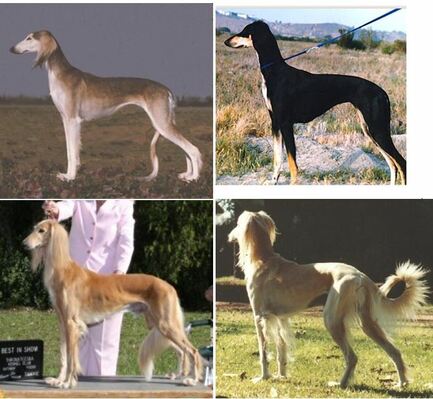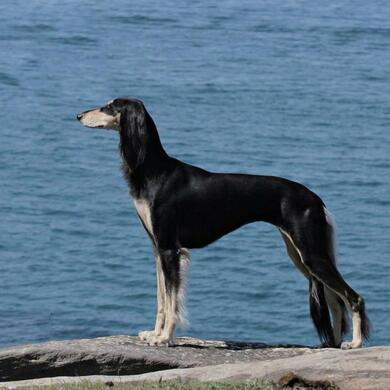Judging the Saluki
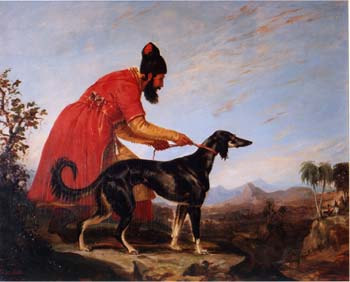
This page: Sources of Information,
The Saluki Standard, General Appearance, Size and Proportion
Our standard is short but it gets the job done---on these pages I will post my interpretation of the standard. I will try to separate my personal preferences but be aware it is impossible to choose good and bad examples without personal preferences influencing the choices.
Please note that the Saluki Club of America has its own Judge's Education video which is available on a link below. I also encourage prospective judges to speak with and visit a variety of Saluki breeders. Some are listed as SCOA mentors but we also have many more well-qualified mentors who are not listed. Ask credentials, listen and decide. I am glad to provide possible contacts or suggest saluki events in your area by private e-mail. Again, these will no doubt be biased so don't stop there!
POWER POINT presentation AKA "Half of Everything You Always Wanted to Know About Salukis But Were Afraid to Ask)"
(Note: links are inactive within it)
Click on the following links for information on this site:
Salukis 101: A Brief Introduction to the Breed
How to Examine a Saluki
History, Styles and Questions
General Appearance (see below)
The Head
Neck and Forequarters
Topline, Chest and Loin
Hindquarters and Tail
Movement
Coat and Color
Not in the Standard
The Brouhaha About Brindle
Saluki Versus Afghan Hound
Cheat Sheet
Self-Test
Outside Links
FCI Standard
SCOA Saluki Webinar
SCOA Power Point
Old AKC SCOA Judge's Ed Video
Australian KC Extended Breed Standard
Judging the Saluki
Breed Priorities (Canine Chronicle)
The Functional Saluki: Lessons From the Coursing Field
The Saluki: Questions Answered
Should a Sighthound's Front Toe In, Out, or be Dead Ahead?
But isn't something missing from the saluki standard?
What does brief saluki standard tell us about the breed?
Brian Duggan's Saluki Research (extensive historical information, including history of the Standard)
Oriental Greyhounds by Florence Amherst (1907, from Cassell's New book of the Dog).
Saluki Standard: Filling in the Gaps
Hunting in the Middle East (Videos)
Saluki Hunting Documentary
Race the Wind
Hunting Hare
Modern Gazelle Hunt
Saluki Race in Dubai
Breed Judging Videos
2022 Westminster
2019 Westminster
2020 Westminster
2021 Westminster
2010 AKC National Championship
Saluki Events
- The Saluki Club of America National Specialty is held every year in June at Purina Farms near St Louis, MO.
- The American Saluki Association's unofficial national specialty ("Celebration") is held every July in Lompoc, CA (This year it is in Arizona in October).
- Many regional Saluki Clubs hold special events.
- In Florida, C-FLASH holds a specialty in Ocala every November.
- You may also meet salukis lure-coursing. Find trials through www.ASFA.org or through the AKC events calendar.
The AKC Saluki Standard
Head: Long and narrow, skull moderately wide between the ears, not domed, stop not pronounced, the whole showing great quality.
Nose black or liver.
Ears: Long and covered with long silky hair hanging close to the skull and mobile.
Eyes: Dark to hazel and bright; large and oval, but not prominent.
Teeth: Strong and level.
Neck: Long, supple and well muscled.
Chest: Deep and moderately narrow.
Forequarters: Shoulders sloping and set well back, well muscled without being coarse.
Forelegs Straight and long from the elbow to the knee.
Hindquarters: Strong, hipbones set well apart and stifle moderately bent, hocks low to the ground, showing galloping and jumping power.
Loin and Back: Back fairly broad, muscles slightly arched over loin.
Feet: Of moderate length, toes long and well arched, not splayed out, but at the same time not cat-footed; the whole being strong and supple and well feathered between the toes.
Tail: Long, set on low and carried naturally in a curve, well feathered on the underside with long silky hair, not bushy.
Coat: Smooth and of a soft silky texture, slight feather on the legs, feather at the back of the thighs and sometimes with slight woolly feather on the thigh and shoulder.
Colors: White, cream, fawn, golden, red, grizzle and tan, tricolor (white, black and tan) and black and tan.
General Appearance: The whole appearance of this breed should give an impression of grace and symmetry and of great speed and endurance coupled with strength and activity to enable it to kill gazelle or other quarry over deep sand or rocky mountains. The expression should be dignified and gentle with deep, faithful, far-seeing eyes. Dogs should average in height from 23 to 28 inches and bitches may be considerably smaller, this being very typical of the breed.
The Smooth Variety-In this variety the points should be the same with the exception of the coat, which has no feathering.
The actual Standard takes precedence over any additions to or interpretations of it.
Comment: A note on the word "moderate." You will often hear saluki fanciers claim that moderate is the most often used word in the standard (it is not) and thus everything about the saluki should be moderate. This is both true and untrue. The saluki should be moderate where the standard calls for it: "Moderately wide between the ears," chest "moderately narrow," stifle "moderately bent," feet of "moderate length." Some fanciers have further morphed the word "moderate" into "straight" when speaking of stifle angulation, and worst of all, have confused it with lack of anythingness, so that the plainest most poorly moving (by conventional standards) is their ideal of moderate. Salukis ARE moderate in the sense they are not naked Afghans; they do not have German Shepherd movement; and they should be neither fragile refined nor bulky built. Salukis should be moderate where the standard calls for it, and like any breed, should avoid extremes.
Comment: A note on the word "moderate." You will often hear saluki fanciers claim that moderate is the most often used word in the standard (it is not) and thus everything about the saluki should be moderate. This is both true and untrue. The saluki should be moderate where the standard calls for it: "Moderately wide between the ears," chest "moderately narrow," stifle "moderately bent," feet of "moderate length." Some fanciers have further morphed the word "moderate" into "straight" when speaking of stifle angulation, and worst of all, have confused it with lack of anythingness, so that the plainest most poorly moving (by conventional standards) is their ideal of moderate. Salukis ARE moderate in the sense they are not naked Afghans; they do not have German Shepherd movement; and they should be neither fragile refined nor bulky built. Salukis should be moderate where the standard calls for it, and like any breed, should avoid extremes.
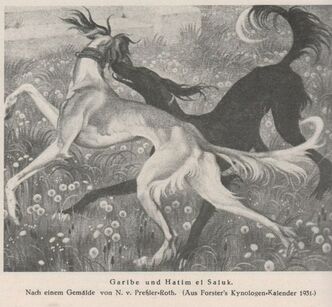 Saluki painting from 1931.
Saluki painting from 1931.
The Saluki Standard Overview
General Appearance: The whole appearance of this breed should give an impression of grace and symmetry and of great speed and endurance coupled with strength and activity to enable it to kill gazelle or other quarry over deep sand or rocky mountains. The expression should be dignified and gentle with deep, faithful, far-seeing eyes. Dogs should average in height from 23 to 28 inches and bitches may be considerably smaller, this being very typical of the breed.
The words that stand out to me are "grace" "speed" "endurance" and "strength"---some of which tend to call for opposite traits. For me "grace" is seen in flowing lines and lightness of movement; "speed" in a racy outline with light bone, long legs, good tuck and slightly arched loin; "endurance" again in slight build; "strength" in making sure it's not too slight!
The underline is an important aspect of type and function. Bitches have the advantage here, as they always look racier (unless in a false pregnancy, which can be very obvious). They need not be wasp-waisted, but dogs and bitches should have a noticeable tuck up. You may need to overlook the male's privates in order to see his body shape. Some Salukis have a curtain of skin that can hide an otherwise nice tuck.
The saluki was bred to run down a wide variety of quarry over diverse terrain. To be successful they must have the speed to catch their swift prey, the endurance to outlast it, the strength to bring it down, and---well, I'm not sure what they were getting at with the term "activity." I suppose energy? Willpower to get off the couch?
The saluki is the endurance runner of the sighthounds. To do so it needs a light body frame with long rather than bunchy muscles. It needs long legs. Its feet are "off-road" feet; large and fairly hare-footed, deep but flatter than a Greyhound foot. But it also has the trademarks of speed: slightly arched loin, good tuck-up and streamlined body.
Its prey historically ranged from hare to gazelle to fox to rarely, wild ass, and its native land is the wide expanse of the Middle East. Taken together, this allows for, and even demands, a wide range of acceptable styles.
The writers of the standard considered the expression important enough to include under the general description. Middle Eastern tribes valued the saluki first for its hunting ability, but also for its beauty.
The Arabs preferred that three ribs, three vertebra and both hipbones show. This is a good coursing weight but generally on the thin side for ring success. But it should not be faulted when you see it---as long as muscles go with it, and not just skinniness. Salukis should be svelte, not skinny!
COMMENT: I often see judges trying to decide their winner by measuring which has a micron's worth of smoother withers or reach. Too often they end up putting up the generic dog when what they needed to do was to step back and ask themselves which dog fulfils the requirements of the General Appearance part of our standard. This is a hunting galloping dog, not a trotting dog---although we do appreciate easy powerful light movement at a trot. But first of all it should look like a saluki, with a sighthound profile and proportions, a combination of grace, speed, endurance and strength. Only once these are fulfilled should you start measuring withers and such, and to be honest, saluki folks would rather you look at the whole rather than measure the parts.
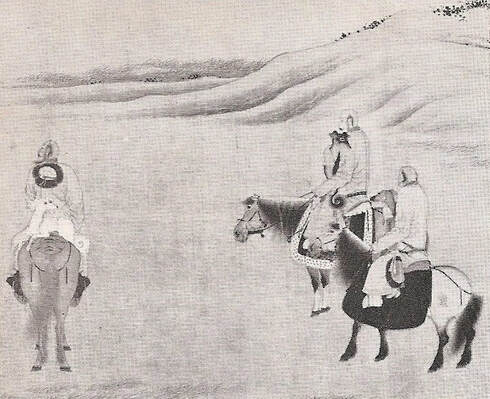 "Hunters Homeward Bound" from the 10th century AD. Ink on silk Hu Huai. Khirgiz tribesmen return from a hunt on the Asian steppes each carrying a saluki on horseback. Note the small size of the salukis.
"Hunters Homeward Bound" from the 10th century AD. Ink on silk Hu Huai. Khirgiz tribesmen return from a hunt on the Asian steppes each carrying a saluki on horseback. Note the small size of the salukis.
Size
AKC Standard: "Dogs should average in height from 23 to 28 inches and bitches may be considerably smaller, this being very typical of the breed."
Discussion: As with the wide range in styles the breed should have a wide range in size. Most dogs in the show ring today are grouped at the highest two inches of the standard, and some even above it. You will NEVER see a male or female saluki that is too small, but you will see many that are too large. Some proponents of larger dogs contend the wording "average in height" means that it is OK to be over the stated standard height. However, there is no such thing as an average range in statistics, and this argument would assume that if there are 30-inch males there must also be 21-inch males (There are not).
I believe that the writers of the standard, in their attempt to be inclusive of the various lines of salukis in England at the time, allowed for a wide preferred range, but acknowledged that a few might fall outside of it and still be acceptable. Remember that the standard was a compromise, mostly between the two main families of salukis at the time. The Amhearstias (according to the standard Florence Amhearst drew up) averaged 23 inches for males and 21 inches for females, while the Saronas were not uncommonly as tall as 28 inches.
My personal opinion is that given this wide range, if a dog is more than an inch over, he had better be otherwise perfect for me to forgive it. And since it seems we always battle creeping size, in a TOTAL TIE my preference always goes to the smaller dog (but under other circumstances any dog within the height range should be equally rewarded). However, a 28-inch bitch is too large in my opinion.
Some breeders of larger salukis claim salukis were also used to hunt wild ass, and perhaps this did occur. But the major quarry of the saluki was the gazelle (which is not a large antelope) and hare. In addition, running over sand and rocks, and existing on scant food and water, favored a smaller dog.
Salukis were supposed to be able to ride to the hunt on horseback. Too many of our present salukis would require a Clydesdale to ride on, whereas I suspect they were riding Arabians!
The standard makes no mention of weight. But a 27 to 28" male will generally weigh from 55 to 60 lb; a typical bitch will weigh around 40 to 45 lb. With either, plus or minus 5 lb. would not be at all unusual.
PROPORTON: The standard doesn't specifically mention proportion, but it does have one very telling line: "Forelegs straight and LONG FROM ELBOW TO KNEE." The FCI Standard states: "Important proportions: The length of the body (from point of shoulder to point of buttock) is approximately equal to the height at the withers, although the dog often gives the impression of being longer than he really is."
Salukis have long legs; not Azawakh long, but long. They can be square with long legs and a short body, or slightly long with long legs and a long body, but never short-legged. If one fault is permeating the breed in the 2010's, it's short legs---especially short front legs. They make for great trotting dogs but not great running dogs. Both of the bitches below have long legs, yet their proportions are different---and equally correct. In both cases the distance from ground to elbow is much more than the distance from elbow to withers. At the same time, a saluki should not be taller than long.
Note: According to Gail Goodman: "Body proportions <of current Middle Eastern salukis>, when actually measured (refer to the numerous tables in The Saluqi: Coursing Hound of the East, 1995, ed. G. Goodman) range from the height at the withers being greater than the length of body from the point of shoulder to the point of the pelvis (often by as much as two inches) as the most frequently occurring shape, with some Salukis measuring square, while very few actually measure rectangular."
Remember this is a dog built for speed! And I don't mean Weiner races! Salukis are never meant to be "long and low!"
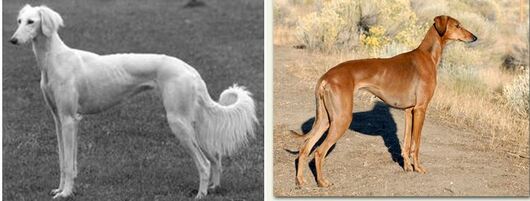
Next Page: The Head
